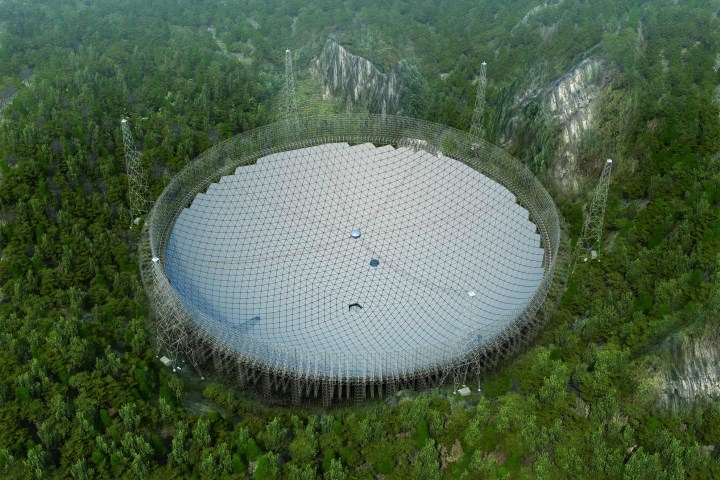
After years in development, construction workers slotted into place the final piece of the 500-meter aperture spherical telescope (aka FAST) back in July. And following months of testing, FAST became fully operational on September 25. The giant telescope will aid in China’s quest to achieve “major advances and breakthroughs at the frontier of science,” China’s President Xi Jinping said in a congratulatory message on Sunday. Calling the telescope the nation’s “eye in the sky,” Xi and other Chinese officials certainly have high hopes for the world’s largest single-dish radio telescope.
It’s a symbolic achievement for China, which is aiming to prove not only its economic well-being, but its scientific prowess as well. “Astronomy is an ultimate expression of ‘pure’ science that has little immediate practical benefits,” Luis C. Ho, the director of the Kavli Institute for Astronomy and Astrophysics at Peking University, told the New York Times via email. “It is a luxury that only the most advanced economies enjoy.” And now, it’s a luxury that exists in the backyard of one of China’s most impoverished areas.
The telescope comprises 4,500 panels, each measuring about 11 meters (36 feet) in length and which together form an enormous dish. The design will allow researchers to make minute adjustments to the shape of the dish, enabling them to reflect faraway radio signals to a single focal point for detailed examination.
It’s big, really big
Suggesting that for astronomers, size really does matter, China’s gigantic radio telescope gives us the best chance yet of locating possible alien life in distant parts of the universe.
“With a larger signal receiving area and more flexibility, FAST will be able to scan two times more sky area than Arecibo [currently the largest operational radio telescope], with three to five times higher sensitivity,” National Astronomical Observatories chief scientist Li Di told the China Daily last year.
Besides detecting radio signals from billions of light years away, the telescope will also be able to spot new galaxies, extrasolar planets, and highly magnetic neutron stars, or pulsars. It is hoped that the gathered information will help scientists learn more about the evolution of our universe.
FAST is located in China’s south-western province of Guizhou, about 1,000 miles (1,610 km) south-west of Beijing. Its construction, at a cost of around $185 million, forms part of the nation’s efforts to create a full-fledged space program, a key ambition of its current leader, President Xi Jinping. Other plans include getting an astronaut to the moon and the creation of an orbiting space station, with construction planned to begin in 2018.
The telescope’s construction has resulted in the displacement of more than 2,000 families — around 9,000 people — living within three miles of the construction site. The government insisted that moving residents from the area was necessary in order to “create a sound electromagnetic wave environment” for the telescope. Officials handed each affected resident compensation of 12,000 yuan (about $1,800), equivalent to around half the average salary for Chinese workers, before resettling them in nearby locations.
While other huge radio telescopes have so far failed to find alien life, let’s hope FAST can happen upon something in the coming years to prove decisively that we are not alone.
Article originally published July 4, 2016. Updated on 09-25-2016 by Lulu Chang: Added news that FAST is now fully operational.


